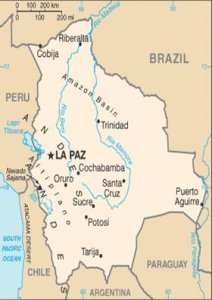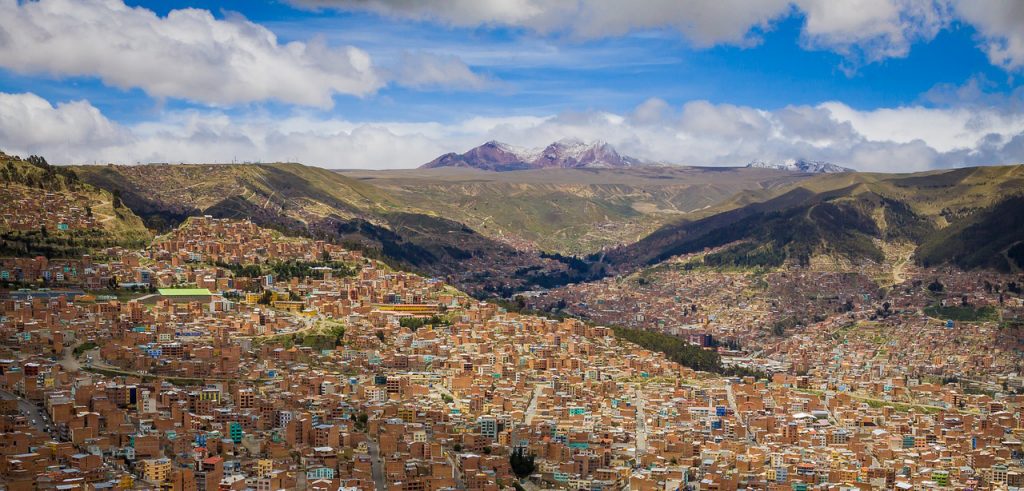
GEOGRAPHY
Bolivia is a landlocked country bordered by Peru to the northwest, Brazil to the north and east, Paraguay to the southeast, Argentina to the south and Chile to the west. There are three main areas: the first is a high plateau known as the ‘Altiplano’, a largely barren region lying approximately 13,000ft above sea level. It com-prises 10 per cent of the country’s area and contains 70% of the population, nearly one-third of whom are urban dwellers. The second area is a fertile valley situated5,900ft to 8,850ft above sea level. The third area comprises the lowland tropics which stretch down to the frontiers with Brazil, Argentina and Paraguay, taking Argentina and Paraguay, taking up some 70% of the land area. Rainfall in this region is high, and the climate is hot.
HISTORY

Bolivia, named after independence fighter Simon BOLIVAR, broke away from Spanish rule in 1825; much of its subsequent history has consisted of a series of nearly 200 coups and counter-coups. Comparatively democratic civilian rule was established in the 1980’s, but leaders have faced difficult problems of deep-seated poverty, social unrest, and drug production. Current goals include attracting foreign investment, strengthening the educational system, resolving disputes with coca growers over Bolivia’s counter-drug efforts, continuing the privatization program, and waging an anticorruption campaign.
THE PEOPLE
Of the indigenous people, about 30% are Quechua and 25% are Aymara, and 15% are the citizens of European descent.
SOCIAL CONVENTIONS
Normal social courtesies in most Bolivian families and respect for traditions should be observed. Remember to refer to rural Bolivians as campesinos rather than Indians, which is considered an insult. Female campesinos still adhere to their traditional dress. A suit and tie for men and dress for women should be worn for smart social occasions. Casual wear is otherwise suitable. Smoking is accepted unless indicated otherwise. Time keeping is poor.
LANGUAGES
The official languages are Spanish, Quechua and Aymará. English is also spoken by a small number of officials and businesspeople in commercial centers.
GOVERNMENT
Republic. Gained independence from Spain in 1825.
TIME ZONE
Bolivia’s local time is kept constant throughout the year. Its time zone is four hours behind Greenwich Mean Time, and one hour ahead of U.S. Eastern Standard Time (EST).
ELECTRICITY
110/220 volts AC in La Paz, 220 volts AC, 50Hz in the rest of the country. Most houses and hotels have two-pin sockets for both electrical currents. Variations from this occur in some places.
CLIMATE
Climatic conditions vary sharply. From west to east, mean annual temperatures increase progressively from the chill of the Altiplano, between -37ºF and 54ºF, to the tropical warmth of the lowlands, between at 68ºF and 82ºF. In the intermediate valleys mean temperatures are mild and oscillate from 59ºF to 68ºF.
In the highlands temperature tends to fall sharply by night. Rainfall takes place from October through April, although it varies from year to year. Both floods and droughts are common.
Clothes to Wear:
Lightweight, natural fabrics and waterproofs. Warmer clothing is necessary at night in the Altiplano, especially La Paz, Oruro and Potosi.
LOGISTICAL
Entry and Exit Requirements:
A U.S. passport valid for at least six months from the date of proposed entry into Bolivia is required to enter and depart Bolivia. As of January 15, 2020 neither US nor Canadian citizens require a visa for leisure stays up to 90 days. Please confirm this with your air carrier and the embassy since such rules may change. An exit tax may be charged when departing Bolivia by air.
U.S. citizens traveling in Bolivia are encouraged to register with the nearest U.S. embassy or consulate at the Department of State’s travel registration page in order to obtain updated information on local travel and security.
Embassy Locations:
United States Embassy in Bolivia
Avenida Arce 2780, La Paz
Tel: 591-2-216-8246
Emer. A/hours tel: 591-715-33713
Fax: 591-2-216-8809
http://bolivia.usembassy.gov/
Embassy of Canada in Peru
Bolognesi 228, Miraflores, Lima 18
Tel: 51-1-319-3200
http://www.canadainternational.gc.ca/peru-perou/index.aspx
Health
Western Bolivia, dominated by the Andes and high plains (Altiplano), is largely insect-free. However, altitude sickness can be a problem. High Altitude Health Risks:
The altitude of La Paz ranges from 10,600 feet to over 13,000 feet (3,400 to 4,000 meters) above sea level. Much of Western Bolivia is at the same altitude or higher, including Lake Titicaca, the Salar de Uyuni, and the cities of Oruro and Potosi. Prior to departing the U.S. for high-altitude locations (over 10,000 feet above sea level), travelers should discuss the trip with their personal physician and request information on specific recommendations concerning medication and lifestyle tips at high altitudes. Coca-leaf tea is a popular beverage and folk remedy for altitude sickness in Bolivia. Possession of this tea, which is sold in bags in most Bolivian grocery stores, is illegal in the United States. The State Department’s Office of Medical Services cautions official U.S. Government travelers planning to visit La Paz to consider the following risks and advice:
- Sickle cell anemia or sickle cell trait: 30 percent of persons with sickle cell trait are likely to have a crisis at elevations of more than 8,000 feet. U.S. citizens with this condition have required urgent medical evacuation from La Paz to the U.S.
- Heart disease: Any person who has heart disease, or known risk factors for heart disease, should consult their doctor about their risks of ascending to altitude, and whether any testing of their heart would be in order. Even U.S. citizens who adjust well initially to the altitude in La Paz have subsequently suffered heart attacks and been hospitalized.
- Lung disease: Anyone with emphysema should consult closely with their doctor and seriously reconsider coming to La Paz or surrounding, high altitude areas. Anyone with asthma should consult their doctor; mild asthma may be manageable at high altitude, but it is important to remember that emergency care and intensive respiratory care are very, very limited even in the city of La Paz, and are absent outside the city. U.S. citizens with respiratory ailments have previously been medically evacuated from La Paz to other countries to receive medical treatment.
- Given potential complications from altitude sickness, pregnant women should consult their doctor before travel to La Paz and other high-altitude areas of Bolivia. A higher number of miscarriages have been noted at altitude as well as other pregnancy complications.
All people, even healthy and fit persons, will feel symptoms of hypoxia (lack of oxygen) upon arrival at high altitude. Most people will have increased respiration and increased heart rate. Many people will have headaches, difficulty sleeping, lack of appetite, minor gastric and intestinal upsets, and mood changes. Many travelers limit physical activity for the first 36 to 48 hours after arrival and avoid alcohol and smoking for at least one week after arrival.
Eastern Bolivia is tropical, and visitors to that area are subject to related illnesses. Dengue is endemic throughout eastern Bolivia, including in Santa Cruz city.
Information on vaccinations and other health precautions, such as safe food and water precautions and insect bite protection, may be obtained from the Centers for Disease Control and Prevention’s (CDC) hotline for international travelers at 1-800-CDC-INFO (1-800-232-4636) or via the CDC website at http://wwwnc.cdc.gov/travel. For information about outbreaks of infectious diseases abroad, consult the infectious diseases section of the World Health Organization (WHO) website at http://www.who.int/topics/infectious_ diseases/en/. The WHO website also contains additional health information for travelers, including detailed country-specific health information.
Yellow Fever vaccination may be required for travelers visiting any of the affected areas. Please check to see if the areas you are visiting have been affected prior to traveling.
Banks & Currency:
1 Boliviano (BOB; symbol Bs) = 100 centavos
Money can be changed in hotels and casas de cambio.
American Express, Diners Club, MasterCard and Visa are accepted in most mid- to top-range hotels and restaurants, but otherwise have limited acceptance. There are ATM’s in most larger towns and cities.
There are no import restrictions on local and foreign currency; export restrictions on both local and foreign currency are up to the amounts imported and must be declared.
Banking Hours: Mon-Fri 9am-6pm. Some banks open Sat 9am-1pm.
Communications:
IDD is available. Country code: 591. Outgoing international code: 00. Internet is usually available but may be sporadic in remote areas and the Uyuni region.
Cell Phone Usage:
Please contact your cell phone provider to determine whether your contract includes coverage in the country you are visiting. Depending on your contract you may have to add international services and/or country specific services.
ENTERTAINMENT
Food & Drink:
Bolivian cuisine is distinctive and good quality. Dishes are dominated by meat and often slightly spicy. International and local-style restaurants are available in all main towns. Bottled water and other drinks are widely available.
National specialities:
- Salteña (a mixture of diced meat, chicken, chives, raisins, diced potatoes, hot sauce and pepper baked in dough)
- Lomo montado (fried tender loin steak with two fried eggs on top, rice and fried banana)
- Picante de pollo (southern fried chicken, fried potatoes, rice, tossed salad with hot peppers)
- Chuño (naturally freeze-dried potato used in soup called chairo)
- Lechón al horno (roast suckling pig served with sweet potato and fried plantains).
National drinks:
- Bolivian beer, especially the Huari brand from the Paceña brewery
- Chicha (made from fermented cereals and corn)
- Singani, fermented from grapes, is a popular brandy to mix in cocktails
- Bolivia has a fledgling wine-making industry with its ‘wines at altitude’ from La Concepción label garnering international plaudits.
Nightlife:
La Paz has many nightclubs, which generally get active around midnight. There are also numerous bars. A popular night out is a visit to a peña, a folk music and dancing shows, often accompanied by a late dinner. International visitors may also be interested in events, shows and performances arranged by local cultural centres.
Shopping
Bolivia offers a wealth of artisan goods with special purchases including llama and alpaca-wool products, Indian handicrafts, woodcarvings and gold and silver costume jewellery. The streets around the market area, notably Sagarnaga, Linares and Illampu, are full of small vendors offering goods at lower prices but quality can be variable. There are, however, a few places around La Paz where you can buy good-quality goods and be sure that a percentage of your money is directly going back into the hands of artisans.
BAGGAGE
Baggage rules for international and domestic air travel have changed much in recent years, differ from carrier to carrier and these days even may cover your on-board bags. Checking luggage may cost a separate fee or may be free depending on your personal status with the carrier. We therefore encourage you to read your ticket’s small print and/or contact your carrier for exact rules.
TIPPING
It is customary to add 10% as a tip. Porters also expect tips for each piece of luggage, $1 to $2 will suffice.
LAUNDRY
Laundry service is available at most hotels in the main centers. Generally you should allow 24 hours before the item is returned to you, however, some have an emergency service available at an extra charge.
PHOTOS & VIDEOS
In some countries you must refrain from photographing sites such as Military bases and industrial installations. Also be aware of cultural sensitivities when taking pictures of or near churches and other religious sites. It is always courteous to ask for permission before taking photographs of people.
USE OF DRONES
The use of drones is being legislated by many countries. In some cases drones are already forbidden and their unauthorized use may carry severe penalties. If you plan to travel with a drone please contact the embassy or consulate of the country you wish to visit.
![SITA Canada Final_color [Converted]new_for_wp SITA Canada Final_color [Converted]new_for_wp](https://sitatourscanada.com/wp-content/uploads/2019/12/SITA-Canada-Final_color-Convertednew_for_wp.png)
